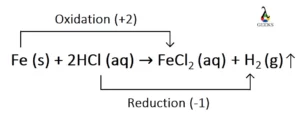HCl is a strong acid, and it reacts with iron filings and a gaseous substance is liberated. Let us explore different relevant facts about the reaction between Fe and HCl.
Fe dissolves in hydrochloric acid (HCl) and forms gaseous H2 and ferrous (FeCl2) chloride. Fe is a transition metal and HCl is a strong acid. In this reaction, heat is generated in the product side as it is an exothermic reaction. The gas evolving burns with a sound which proves that it is a hydrogen gas.
This article will discuss the enthalpy, balancing method, type, titration procedure, ionic equation of this reaction between Fe and HCl in detail.
What is the product of HCl and Fe?
When iron fillings (Fe) react with hydrochloric acid (HCl), hydrogen is replaced from HCl by Fe and forms ferrous chloride (FeCl2). Hydrogen gas also evolved from the reaction medium as bubbles.
Fe (s) + 2HCl (aq) = FeCl2 (aq) + H2 (g)
What type of reaction is HCl + Fe?
The reaction between HCl + Fe is an example of an exothermic reaction (change of enthalpy is negative). It is also considered a redox reaction and a single-displacement reaction. But it is not a neutralization reaction or acid-base reaction.
How to balance HCl + Fe?
The following steps should be followed to balance any chemical reaction-
- The unbalanced chemical equation of the reaction should be written first with a right arrow sign. Fe (s) + HCl (aq) → FeCl2 (aq) + H2 (g)
- Determine the mole numbers of each of the chemical species on the reactant and product side.
| Elements | No of moles on reactant side | No of moles on product side |
| Fe | 1 | 1 |
| H | 1 | 2 |
| Cl | 1 | 2 |
- To balance both sides (reactant and product) we have to multiply 2 with HCl to balance the number of moles of hydrogen and chlorine because the mole numbers of rest of the chemical elements are already balanced.
- Therefore, the balanced equation will be – Fe (s) + 2HCl (aq) = FeCl2 (aq) + H2 (g).
HCl + Fe Titration
The titration between HCl + Fe cannot be done because titration is performed to determine the concentration of an analyte. But in this case, a single metal atom (Fe) is used as an analyte. Besides that, it is not an acid-base reaction.
HCl + Fe Net Ionic Equation
The net ionic equation of the chemical reaction HCl + Fe is-
Fe (s) + 2H+ (aq) + 2Cl– (aq) = Fe2+ (aq) + 2Cl– (aq) + H2 (g)
HCL + Fe Conjugate Pairs
We cannot write the conjugate pair equation of the chemical reaction HCl + Fe because it is not an acid-base reaction. We can only write the conjugate pair of HCl which is Cl–. FeCl2 or Fe cannot accept or donate H+ ions. Therefore, there is no conjugate pair of Fe or FeCl2.
HCl and Fe Intermolecular Forces
The intermolecular forces act on HCl and Fe are-
- Being a polar covalent compound, dipole-dipole interaction, London dispersion forces, and hydrogen bonding are working between HCl.
- Fe is a single metal atom. Therefore, there are no intermolecular or intramolecular forces present in it. Depending upon the nature of the compounds formed by Fe, the intermolecular forces will be determined.
HCl + Fe Reaction Enthalpy
The enthalpy changes of the chemical reaction HCl + Fe is -89.12 KJ/mol and this is obtained from the below mathematical calculation.
- The enthalpy of the reactant side is 0 KJ/mol (for Fe) and -167.15 KJ/mol (for HCl). The enthalpy values for the products are -423.42 (for FeCl2), and 0 (H2) KJ/mol.
- The change of enthalpy = {Enthalpy (products) – Enthalpy (reactants)} = [-423.42 + 0 – {0 + 2× (-167.15)}] KJ/mol. = -89.12 KJ/mol.
Is HCl + Fe a buffer solution?
HCl + Fe cannot be a buffer solution because a buffer solution is prepared between a weak acid and its conjugate base or a weak base and its conjugate acid. In this mixture, HCl is a strong acid and Fe is a metal atom that simply acts as a reducing and oxidizing agent respectively.
Is HCl + Fe a complete reaction?
HCl +Fe can only be a complete reaction if it is written with the expected products of this reaction, which are the ferrous chloride and the hydrogen gas.
Fe (s) + HCl (aq) = FeCl2 (aq) + H2 (g)
Is HCl + Fe an exothermic or endothermic reaction?
HCl + Fe is an exothermic reaction because the change of enthalpy is negative in this reaction which is -89.12 KJ/mol and heat is generated on the product side. It indicates that the products are more stable than reactants.
Is HCl + Fe a redox reaction?
- HCl + Fe is an example of a redox reaction. In this reaction, Fe acts as the reducing and HCl acts as the oxidizing agent. Fe is in a 0 (Fe) and +2 (FeCl2) oxidation state on the reactant and the product sides respectively.
- Similarly, hydrogen is in +1 (HCl) and 0 (H2) oxidation states on the reactant and product side respectively.
- Therefore, Fe is reduced, and hydrogen is oxidized in this reaction.

Is HCl + Fe a precipitation reaction?
HCl + Fe is not a precipitation reaction because no precipitation appears in the reaction medium. Ferrous chloride (FeCl2) is completely soluble and H2 is evolving out as bubbles from the reaction medium.
Is HCl + Fe reversible or irreversible reaction?
- HCl + Fe is not an example of a reversible reaction because a gas (H2) is obtained on the product side and gas molecules have large amount of entropy than a liquid and solid. Due to this, the product side has greater stability than the reactant side, and the reaction equilibrium shifts toward the product side according to Le-Chatelier’s principle.
- The reaction is an exothermic reaction which also indicates that the heat is released on the product side. Therefore, products are more stable than the reactants and it is considered as an irreversible reaction.
Is HCl + Fe displacement reaction?
HCl + Fe is a single-displacement reaction because, in this reaction, Fe displaces hydrogen from HCl and forms ferrous chloride (FeCl2) and gaseous hydrogen.
Conclusion
The Fe-HCl mixture is a very important reagent for the deprotection of oximes and selective oxidative hydrolysis of nitroalkane or nitroalkenes to the corresponding ketone. This mixture also helps to reduce the aromatic primary amines.

Hello,
I am Aditi Ray, a chemistry SME on this platform. I have completed graduation in Chemistry from the University of Calcutta and post graduation from Techno India University with a specialization in Inorganic Chemistry. I am very happy to be a part of the Lambdageeks family and I would like to explain the subject in a simplistic way.
Let’s connect through LinkedIn-https://www.linkedin.com/in/aditi-ray-a7a946202